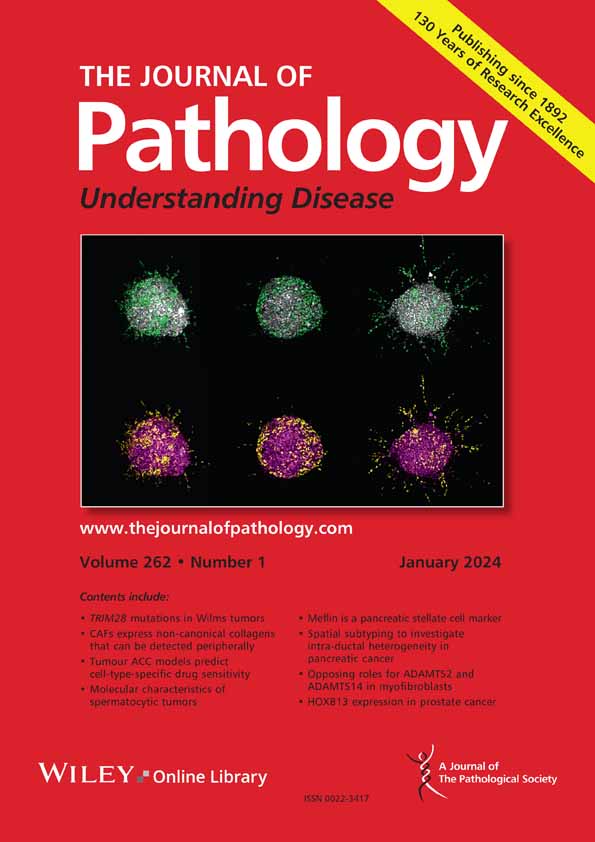Saiganesh Sriraman, Verneri Virtanen, Antti Kukkula, Mervi Toriseva, Anni Lumiainen, Gun West, Matti Poutanen, Pekka Taimen, Maria Sundvall
求助PDF
{"title":"Androgen receptor-mediated regulation of BRCA1 modulates the antioxidant defense in prostate cancer.","authors":"Saiganesh Sriraman, Verneri Virtanen, Antti Kukkula, Mervi Toriseva, Anni Lumiainen, Gun West, Matti Poutanen, Pekka Taimen, Maria Sundvall","doi":"10.1002/path.6468","DOIUrl":null,"url":null,"abstract":"<p><p>Lethal prostate cancer (PCa) is a genetically heterogeneous disease characterized by evolving androgen receptor (AR) signaling, eventually culminating in castration resistance. The tumor suppressor gene BRCA1 has multiple functions that include secondary processes cooperating with its main function as a caretaker of genomic integrity. BRCA1 is often mutated in breast and ovarian cancer, but BRCA1 mutations are also associated with PCa, although they are less frequently observed. Most PCa patients do not, however, carry BRCA1 mutations, and interestingly, it has been shown that BRCA1 expression is enriched in castration-resistant PCa. In this study we elucidated the prostate tissue-specific role of the BRCA1 protein. Although the regulation of DNA damage response genes has been studied in PCa, comprehensive analyses of BRCA1 regulation in the context of androgen signaling are lacking. Our results indicate that BRCA1 is dynamically regulated by AR signaling and that activation of AR via its natural ligand, dihydrotestosterone, represses BRCA1 expression. Our analyses both in vitro and of patient samples and mouse xenografts showed that BRCA1 expression was induced and sustained after androgen deprivation. Moreover, we observed that oxidative stress-related pathways were regulated by BRCA1 in PCa cells and that androgen deprivation therapy-induced activation of BRCA1 supported the function of NRF2, the master regulator of antioxidant defense, and a known interactor of BRCA1. Impaired NRF2 activity, in the absence of BRCA1, decreased growth in a 3D environment. Our findings shed light on the functional role of BRCA1 protein in PCa and suggest that BRCA1 is regulated by the evolving AR signaling state during PCa progression. Thus, AR-mediated suppression of BRCA1 accumulates oncogenic alterations in the early phases of PCa tumor progression and safeguards from excessive reactive oxygen species (ROS) when upregulated during androgen deprivation therapy. © 2025 The Author(s). The Journal of Pathology published by John Wiley & Sons Ltd on behalf of The Pathological Society of Great Britain and Ireland.</p>","PeriodicalId":232,"journal":{"name":"The Journal of Pathology","volume":" ","pages":""},"PeriodicalIF":5.2000,"publicationDate":"2025-10-06","publicationTypes":"Journal Article","fieldsOfStudy":null,"isOpenAccess":false,"openAccessPdf":"","citationCount":"0","resultStr":null,"platform":"Semanticscholar","paperid":null,"PeriodicalName":"The Journal of Pathology","FirstCategoryId":"3","ListUrlMain":"https://doi.org/10.1002/path.6468","RegionNum":2,"RegionCategory":"医学","ArticlePicture":[],"TitleCN":null,"AbstractTextCN":null,"PMCID":null,"EPubDate":"","PubModel":"","JCR":"Q1","JCRName":"ONCOLOGY","Score":null,"Total":0}
引用次数: 0
引用
批量引用
Abstract
Lethal prostate cancer (PCa) is a genetically heterogeneous disease characterized by evolving androgen receptor (AR) signaling, eventually culminating in castration resistance. The tumor suppressor gene BRCA1 has multiple functions that include secondary processes cooperating with its main function as a caretaker of genomic integrity. BRCA1 is often mutated in breast and ovarian cancer, but BRCA1 mutations are also associated with PCa, although they are less frequently observed. Most PCa patients do not, however, carry BRCA1 mutations, and interestingly, it has been shown that BRCA1 expression is enriched in castration-resistant PCa. In this study we elucidated the prostate tissue-specific role of the BRCA1 protein. Although the regulation of DNA damage response genes has been studied in PCa, comprehensive analyses of BRCA1 regulation in the context of androgen signaling are lacking. Our results indicate that BRCA1 is dynamically regulated by AR signaling and that activation of AR via its natural ligand, dihydrotestosterone, represses BRCA1 expression. Our analyses both in vitro and of patient samples and mouse xenografts showed that BRCA1 expression was induced and sustained after androgen deprivation. Moreover, we observed that oxidative stress-related pathways were regulated by BRCA1 in PCa cells and that androgen deprivation therapy-induced activation of BRCA1 supported the function of NRF2, the master regulator of antioxidant defense, and a known interactor of BRCA1. Impaired NRF2 activity, in the absence of BRCA1, decreased growth in a 3D environment. Our findings shed light on the functional role of BRCA1 protein in PCa and suggest that BRCA1 is regulated by the evolving AR signaling state during PCa progression. Thus, AR-mediated suppression of BRCA1 accumulates oncogenic alterations in the early phases of PCa tumor progression and safeguards from excessive reactive oxygen species (ROS) when upregulated during androgen deprivation therapy. © 2025 The Author(s). The Journal of Pathology published by John Wiley & Sons Ltd on behalf of The Pathological Society of Great Britain and Ireland.
雄激素受体介导的BRCA1调控前列腺癌的抗氧化防御。
致死性前列腺癌(PCa)是一种遗传异质性疾病,其特征是雄激素受体(AR)信号的进化,最终导致去势抵抗。肿瘤抑制基因BRCA1具有多种功能,包括次要过程与其作为基因组完整性守护者的主要功能合作。BRCA1在乳腺癌和卵巢癌中经常发生突变,但BRCA1突变也与PCa相关,尽管它们不太常见。然而,大多数PCa患者不携带BRCA1突变,有趣的是,研究表明BRCA1在去势抵抗性PCa中表达丰富。在这项研究中,我们阐明了BRCA1蛋白在前列腺组织中的特异性作用。虽然已经研究了PCa中DNA损伤反应基因的调控,但缺乏对雄激素信号背景下BRCA1调控的全面分析。我们的研究结果表明,BRCA1受AR信号的动态调控,AR通过其天然配体双氢睾酮激活,抑制BRCA1的表达。我们对体外、患者样本和小鼠异种移植物的分析表明,雄激素剥夺后,BRCA1的表达被诱导并持续。此外,我们观察到PCa细胞中的氧化应激相关通路受BRCA1调控,雄激素剥夺疗法诱导的BRCA1激活支持NRF2的功能,NRF2是抗氧化防御的主要调节因子,也是BRCA1的已知相互作用物。在缺乏BRCA1的情况下,NRF2活性受损会导致3D环境下的生长下降。我们的研究结果揭示了BRCA1蛋白在PCa中的功能作用,并表明BRCA1在PCa进展过程中受AR信号状态的调节。因此,ar介导的BRCA1抑制在PCa肿瘤进展的早期阶段积累了致癌改变,并且在雄激素剥夺治疗期间上调时防止过多的活性氧(ROS)。©2025作者。《病理学杂志》由John Wiley & Sons Ltd代表大不列颠和爱尔兰病理学会出版。
本文章由计算机程序翻译,如有差异,请以英文原文为准。

 求助内容:
求助内容: 应助结果提醒方式:
应助结果提醒方式:


